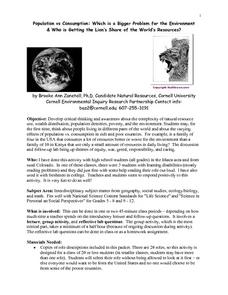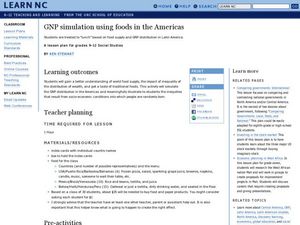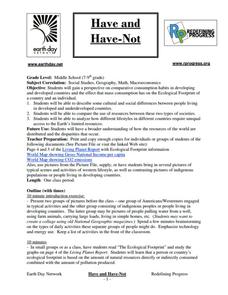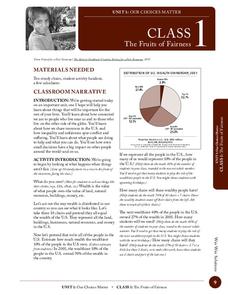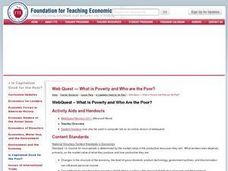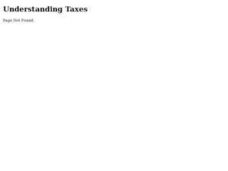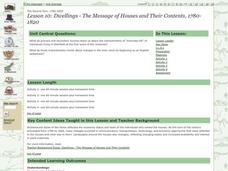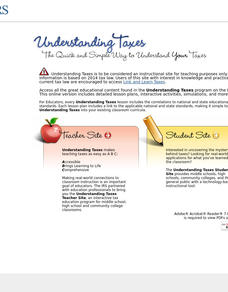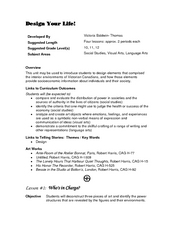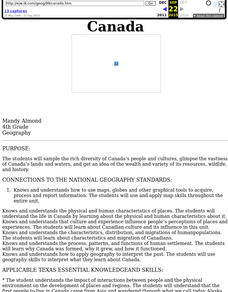Curated OER
Wealth Dispersal in the US
Some handouts speak for themselves. Give your economics class a better grasp on the dispersal of wealth in America. The handout compares the total US wealth to 100 dollars. A graph then shows how that 100 dollars is distributed amongst a...
Curated OER
The Scramble for Wealth And Power
Young scholars participate in a simulation activity involving the distribution of the world's wealth and power. The activity starts when 100 pennies, representing wealth and power, are spread on the floor and students must grab as many...
Curated OER
"Globalization"
An interesting activity that will spark a great class discussion on globalization and wealth distribution around the world. Each group is asked to accomplish the same task, but are not given equal access to materials. It is up to them to...
Curated OER
Population Vs Consumption: Which is a Bigger Problem for the Environment & Who is Getting the Lion's Share of the World's Resources?
Students develop critical thinking and awareness about the complexity of natural resource use, wealth distribution, population densities, poverty, and the environment. They think about people living in different parts of the world and...
Curated OER
Social Inequality
For this Social Inequality, students answer questions and complete a t-chart by providing examples of marketable and non-marketable wealth.
Curated OER
GNP Simulation Using Foods in the Americas
Young scholars explore food supply distribution. In this GNP distribution lesson, students participate in a simulation that requires them to eat foods from the American continents. Young scholars are served according to their chance...
iCivics
Taxation
A paycheck stub can offer loads of information on the taxes American citizens pay. This resource not only includes analysis of a stub as an activity, but also provides a wealth of informative reading material on such topics as the...
Redefining Progress
Have and Have-Not
Is there a correlation between a country's wealth and the extent of its ecological footprint? What exactly constitutes an ecological footprint, and how does one country stack up against the rest? This is a unique instructional activity...
Curated OER
Non-Western Economic Values
Learners engage in a game of economic exchange that present a variety of perspectives on wealth. They read scenarios and write a journal response to the scenario. They discuss how we use money in the Western culture and discuss how...
Curated OER
The Fruits of Fairness
Students examine the distribution of wealth in the US. In this economic distribution lesson, students use math skills to apply real statistics to the students in their classroom making these facts more of a reality.
Curated OER
World Fair? A Global Classroom Unit On Economic Rights
Students explore economic rights of people. After listening to statements and songs by people such as John Lennon and Mahatma Ghandi, students examine the truths and values depicted by each person. Students participate in a simulation to...
Curated OER
Specialization and Voluntary Exchange
Studnets participate in a trading simulation game in which they experience the effects of trade and how trade can increase wealth.
Curated OER
WebQuest- What is Poverty and Who Are the Poor?
Pupils are introduced to a variety of easily accessible data about poverty. The search activity performs double-duty in exposing students to the nature and magnitude of world poverty and in confronting them with different types and...
Curated OER
Contemporary Changes in the Distribution of Income and Wealth
In this Contemporary Changes worksheet, students look at a table (not provided) to answer questions about incomes of wage earners, then complete a graphic organizer about wealthy versus non-wealthy people.
Curated OER
The Wealth Tax of 1935 and the Victory Tax of 1942
Young scholars explain that during the Great Depression and World War II, the Roosevelt administration implemented new, broader, and more progressive taxes in order to cover the costs of the New Deal programs and the war.
University of California
Roots of the Cold War
When and how did the Cold War begin? To answer this question, you will not find a better-organized, in-depth, activity- and inquiry-based resource than this! Executing best teaching practices throughout, each portion of this inquiry...
Curated OER
Dwellings - The Message of Houses and Their Contents, 1780-1820
Eleventh graders explore how architectural styles of the times reflected the economic status and taste of the individuals who owned the houses and how changes in the landscape and in material wealth reflect changes in technology and in...
Practical Action
Climate Change - Who's In Control?
How can both individuals and governments respond to climate change and take responsibility to reduce its effects on our environment? Here you will find three lessons filled with discussion, debate, and role-playing...
Curated OER
Fairness in Taxes
Students identify and describe two criterion of tax fairness: benefits received and the ability to pay and distinguish between wealth and income as measures of ability to pay.
Curated OER
Who Wants to be a Millionaire?
Students examine wealth including analyzing and interpreting the sources of it. In this social responsibility lesson students create their own political cartoon.
Curated OER
Pluralism
Students analyze advantages and disadvantages of living in a plurlistic society. They work in groups, to identify the various groups (blacks, whites, Asians, and Coloureds) in the era of apartheid in South Africa by using primary and...
Curated OER
Design Your Life
Students use three different pieces of art and identify the power struggles that are being represented. In groups, they use the Internet to research the distribution of wealth throughout Canada during the Victorian time period. They...
Curated OER
Canada
Fourth graders sample the rich diversity of Canada's people and cultures, glimpse the vastness of Canada's lands and waters, and get an idea of the wealth and variety of its resources, wildlife, and history.
Curated OER
Begin Reading Seedfolks
Students are introduced to the book Seedfolks and the concept of community. In this Seedfolks literature study instructional activity, the first in a unit, the teacher reads the first half of the book and students answer comprehension...



